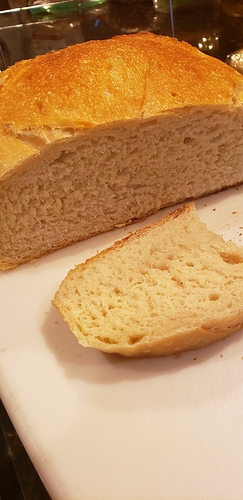I’ve been using the same basic recipe to make sourdough loaves. Last few attempts with my refrigerated starter resulted in little to no rise. I figured the starter may have been too old so I started a new batch from Eric’s dried stuff. The starter seems to be active as after every feeding it’s nice and foamy. Tried twice now using the basic no knead recipe, but am getting nearly no rise whatsoever. I’m stumped.
You stay your starter is foamy … after feeding is it doubling/tripling, i.e. growing up as well?
If you are mixing in a clear class jar or container, put a rubber band around the unfed starter and see how much it grows.
If it is growing up nicely in 4-6-8 hours (depends on temperature), then possibly something in your dough mix is killing the “yeast”.
Since you are using the no knead recipe you have flour, water, salt and I’m guessing you are feeding your starter with the same water you are using in the bread?
A few folks recently reported “bad” flours fixed by lemon juice. I’ve never heard of or needed to try that, but if you search the forum on lemon juice you should find the discussions.
Thanks for replying,
The starter foams to a little less than double.Yes, using the same water as always. I’m going to try another with a different flour and see if that makes any difference.
One other thing is the smell of this new starter. It doesn’t smell sour and is hard to describe. The closest thing I can think of is model airplane glue. Pretty strange.
Airplane glue? Do you mean an acrylic smell?
What hydration is your starter and with what type of flour do you feed it?
If it’s very high hydration and it is foamy that might still be normal. If it’s lower hydration and the bubbles are small and it might be more of a bacteria ferment. That and the acrylic smell indicates it might be lacking in yeasts and/or it’s hungry. A healthy starter if normal hydration will produce bigger bubbles indicating a good population of yeasts present.
Could just be your starter needs TLC with good feeds, allowing it to mature fully before the next feed and at a good temperature of 75-78°F. Once the smell goes away and it bubbles up nicely then it’s good to use.
Thanks for the reply. I’ve been feeding the starter with 1/3 cup bread flour and 1/4 cup water daily since I re-hydrated it 2 weeks ago. Yes, sort of an acrylic smell.
It’s hungry and probably due to maintenance issues it is lacking in yeasts. I don’t work in cups but I belive that would be very hydrated. How about for the next few feeds do as follows…
Keep 1/4 cup starter and feed it half a cup water + 1 cup flour. Correct me if I’m wrong but that should be a healthy feed of 60g starter + 118g water + 120g flour. So near enough 1:2:2.
Keep at 76-78F
When peaked feed again. So you should be looking about every 12 hours or twice a day but of it needs more time then wait until it’s active and bubbly before feeding again.
Repeat a few times till the acrylic smell disappears. Should be healthy enough by then.
Thanks, Abe. I’ll give that a shot.
If your starter is capable of producing lots of bubbles then try mixing 1 cup starter and 1 cup of warm water, 3 1/2 cups white flour and a teaspoon of Kosher or sea salt. Using your dough hook on low-speed, start mixing’ then once the dough starts coming off the sides of your mixer bowl, then continue to knead it for about 8-10 minutes until the dough is soft and smooth. Do your first rise in a lightly oiled covered bowl until it’s at least 70% to 90 % larger than when you started, punch it down flatten it out with your hands and then do a couple envelope folds then shape into a loaf about 8 or 9 inches long and using a regular loaf pan (for training purposes) then do a second rise until it’s a least to the top of, and no more than 1 inch above the rim of the bread pan. You can use your oven with just the light on as a warm place to raise your dough. Once that’s done then bake it in a preheated 350° oven for around 35 to 45 minutes or until it’s golden brown. The loaf needs to be 190° to 200° when stuck in the middle with a thermometer… if you have one. (Amazon sells a stick thermometer for $6) Take it out of the pan and allow it to cool on a cooling rack or wire trivet. Then comes the hardest part… DO NOT CUT into the loaf until it’s cool to the touch. All the loaves in the picture were made from this same basic recipe except they were baked in Romertoupf clay pots. Have some fun this isn’t rocket science it’s just like riding a bike there is a learning curve and you may skin a knee or two but eventually, you’ll get it and laugh about the loaves you threw out back to feed the birds. Well, the birds who have very strong beaks at least. Happy baking😃
Edit or delete this
Wow, some of these answers are quite lengthy. My answer? I had the same issue, and then I converted my starter flour to whole wheat… didn’t change a single other thing… worth a try, or go a step further and use rye, it’s even more active than whole wheat.

